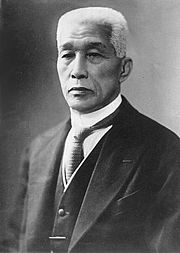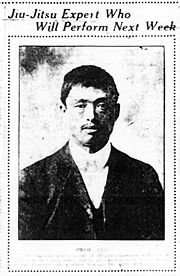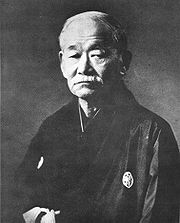
Seattle Dojo
Encyclopedia

Squire Park, Seattle, Washington
Squire Park is a district in the city of Seattle, in the US state of Washington. According to the Squire Park Community Council, it is bounded on the south by S. Jackson Street, on the west by 12th Avenue and 12th Avenue S., on the north by E...
neighborhood of Seattle, Washington
Seattle, Washington
Seattle is the county seat of King County, Washington. With 608,660 residents as of the 2010 Census, Seattle is the largest city in the Northwestern United States. The Seattle metropolitan area of about 3.4 million inhabitants is the 15th largest metropolitan area in the country...
. It is the oldest judo
Judo
is a modern martial art and combat sport created in Japan in 1882 by Jigoro Kano. Its most prominent feature is its competitive element, where the object is to either throw or takedown one's opponent to the ground, immobilize or otherwise subdue one's opponent with a grappling maneuver, or force an...
dojo
Dojo
A is a Japanese term which literally means "place of the way". Initially, dōjōs were adjunct to temples. The term can refer to a formal training place for any of the Japanese do arts but typically it is considered the formal gathering place for students of any Japanese martial arts style to...
in the continental United States
United States
The United States of America is a federal constitutional republic comprising fifty states and a federal district...
, having been founded sometime before 1907 in what is today the International District
International District, Seattle, Washington
The Chinatown-International District of Seattle, Washington is an ethnic enclave neighborhood and is the center of Seattle's Asian American community. The neighborhood is multiethnic, consisting mainly of people who are of Chinese, Japanese, and Filipino ethnicity...
.
Establishment of the Seattle Dojo

Kodokan
, or the Kodokan Institute, is the headquarters of the worldwide judo community. Literally, kō means "to lecture" or "to spread information," dō means "the way," and kan is "a public building or hall," together translating roughly as "a place for the study or promotion of the way." The Kodokan was...
leader named Yoshiaki Yamashita gave demonstrations of judo at the Seattle Theatre. Witnesses included prominent local businessmen and journalists. This success inspired Seattle's Japanese immigrant community to organize its own judo dojo. The pioneer of the Seattle Dojo appears to have been Iitaro Kono (or Kano), a Kodokan
Kodokan
, or the Kodokan Institute, is the headquarters of the worldwide judo community. Literally, kō means "to lecture" or "to spread information," dō means "the way," and kan is "a public building or hall," together translating roughly as "a place for the study or promotion of the way." The Kodokan was...
judo black belt who arrived in Seattle on May 20, 1903. He remained in Seattle until at least September 18, 1909, when he participated in a judo demonstration for the Alaska-Yukon-Pacific Exposition
Alaska-Yukon-Pacific Exposition
The Alaska–Yukon–Pacific Exposition was a world's fair held in Seattle in 1909, publicizing the development of the Pacific Northwest.It was originally planned for 1907, to mark the 10th anniversary of the Klondike Gold Rush, but the organizers found out about the Jamestown Exposition being held...
. During the 1910s, Kono also started judo clubs in Spokane
Spokane, Washington
Spokane is a city located in the Northwestern United States in the state of Washington. It is the largest city of Spokane County of which it is also the county seat, and the metropolitan center of the Inland Northwest region...
and Chicago.

Olympic Games
The Olympic Games is a major international event featuring summer and winter sports, in which thousands of athletes participate in a variety of competitions. The Olympic Games have come to be regarded as the world’s foremost sports competition where more than 200 nations participate...
, and Kaimon Kudo, a popular professional wrestler of the 1930s and 1940s.
Location of the Seattle Dojo
Until 1934, the Seattle Dojo was located in the basements of various JapantownJapantown
is a common name for official Japanese communities in big cities outside Japan. Alternatively, a Japantown may be called J-town, Little Tokyo, or Nihonmachi , the first two being common names for the Japanese communities in San Francisco and Los Angeles, respectively.-North America:Japantowns were...
hotels. The current structure was built during the spring of 1934. Its architect was Kichio "Allen" Arai, whose better known designs include the Seattle Buddhist Church
Seattle Buddhist Church
The Seattle Buddhist Church is a Japanese Jodo Shinshu Buddhist temple in Seattle, Washington, USA. Although it was designed by Japanese American K.A. Arai, the architect of record was Pierce A. Horrocks, because Arai lacked an architectural license. It replaced an earlier Seattle Buddhist Church...
, the Yakima Buddhist Church, the Idaho-Oregon Buddhist Temple, and the White River Buddhist Temple.
The building is of frame construction, and its only unusual feature is that its floor is mounted on truck springs, thereby literally giving it spring.
Tournaments before World War II
Seattle Dojo held its first regional tournament in March 1907, and for decades after, it generally hosted at least one major regional tournament per year. From 1909 through 1941, the usual venue for these tournaments was Seattle's Nippon Kan TheatreNippon Kan Theatre
The is a former Japanese theater in Seattle, Washington, USA. Built in 1909 as a hotel, it was boarded up in 1942 during the Japanese American internment, but reopened in 1981. It is located in the Kobe Park Building at 628 S. Washington Street, in the former Japantown section of Seattle's...
.

Seattle Dojo after World War II
Due to wartime curfews, the Seattle Dojo closed following the Japanese attack on Pearl HarborPearl Harbor
Pearl Harbor, known to Hawaiians as Puuloa, is a lagoon harbor on the island of Oahu, Hawaii, west of Honolulu. Much of the harbor and surrounding lands is a United States Navy deep-water naval base. It is also the headquarters of the U.S. Pacific Fleet...
in December 1941, and due to the Japanese American internment
Japanese American internment
Japanese-American internment was the relocation and internment by the United States government in 1942 of approximately 110,000 Japanese Americans and Japanese who lived along the Pacific coast of the United States to camps called "War Relocation Camps," in the wake of Imperial Japan's attack on...
, it did not reopen for training until January 1, 1947. Men involved in reopening Seattle Dojo after World War II
World War II
World War II, or the Second World War , was a global conflict lasting from 1939 to 1945, involving most of the world's nations—including all of the great powers—eventually forming two opposing military alliances: the Allies and the Axis...
included Toru Araki, Akira "Poison" Kato, Hiromu "Kelly" Nishitani, and Dick Yamasaki.
The club's first post-war tournament took place on April 26, 1953. The Nippon Kan Theatre did not reopen following the forcible relocation of Seattle's Japanese Americans, so the venue was instead the Nisei Veterans Memorial Clubhouse. This 1953 tournament is notable as the first Pacific Northwest
Pacific Northwest
The Pacific Northwest is a region in northwestern North America, bounded by the Pacific Ocean to the west and, loosely, by the Rocky Mountains on the east. Definitions of the region vary and there is no commonly agreed upon boundary, even among Pacific Northwesterners. A common concept of the...
tournament in which women participated. Five women were involved, three from a club in Portland, Oregon
Portland, Oregon
Portland is a city located in the Pacific Northwest, near the confluence of the Willamette and Columbia rivers in the U.S. state of Oregon. As of the 2010 Census, it had a population of 583,776, making it the 29th most populous city in the United States...
, and two from a club in Vancouver, British Columbia.
During the early 1950s, Seattle Dojo had a very strong adult team, and during May 1954, a Seattle Dojo team that included Kenji Yamada, Shuzo "Chris" Kato, Charles Woo, Tats Kojima, and George Wilson took first place during the US National AAU judo championships.
Instructors and students
Instructors associated with Seattle Dojo over the years include Iitaro Kono (or Kano), Tokugoro Ito, R. Fukuda, Daisuke Sakai, Eitaro Suzuki, Masataro Shibata, Hideo Hama, Hiroshi Kurosaka, Yasuyuki Kumagai, Isamu "Sam" Furuta, Shuzo "Chris" Kato, Fred Sato, and Kenji Yamada. Chuji Sakata, who taught at Tentokukan during the 1930s, was another important Seattle-area judo teacher.Well-known former students include professional wrestler Kaimon Kudo, Southern California judo leader Ken Kuniyuki, martial art historian Robert W. Smith
Robert W. Smith (historian)
Robert W. Smith was an American martial artist and writer most noted for his prodigious output of books and articles about the Asian martial arts and their masters...
and Japanese American Citizens League
Japanese American Citizens League
The was formed in 1929 to protect the rights of Japanese Americans from the state and federal governments. It fought for civil rights for Japanese Americans, assisted those in internment camps during World War II, and led a successful campaign for redress for internment from the U.S...
pioneer James Y. Sakamoto.
Prominent visitors
Prominent visitors to Seattle Dojo before World War II include Tsunejiro TomitaTsunejiro Tomita
, born , was the earliest disciple of judo. His name appears in the first line of the enrollment book of the Kōdōkan. Tomita, together with Saigō Shirō, became first in history of judo to be awarded black belt grade by the founder of judo Kanō Jigorō, who established the ranking system...
in 1910, Hideichi (Hidekazu) Nagaoka in 1934, and Jigoro Kano in 1932 and 1938.
Associated judo clubs
In 1917, the TacomaTacoma, Washington
Tacoma is a mid-sized urban port city and the county seat of Pierce County, Washington, United States. The city is on Washington's Puget Sound, southwest of Seattle, northeast of the state capital, Olympia, and northwest of Mount Rainier National Park. The population was 198,397, according to...
Dojo was established in a building owned by the St. Paul and Tacoma lumber mill. The mill's instructors moved their club to Tacoma's Japantown in 1921, after the mill management decided it needed the space in which the men had been training. Professional wrestler Setsuzo Ota was associated with the Tacoma Dojo in those days, as was his cousin Kohei Yoshida. Both Ota and Yoshida were later active in judo in Southern California.
Another club associated with the St. Paul and Tacoma Dojo was established in the nearby farming community of Fife
Fife, Washington
Fife is a city in Pierce County, Washington, United States. The population was 9,173 at the 2010 census.-History:In 1940, it was described as "Fife...at a valley crossroads in the midst of a thickly settled berry growing and truck-gardening district is represented by a string of markets, taverns,...
in 1923. A third Tacoma-area club, Eatonville
Eatonville, Washington
Eatonville is a town in Pierce County, Washington, United States. The population was 2,758 at the 2010 census.-History:For centuries, Indian people roamed the rivers and streams of the Eatonville area. Indian Henry was one of those who, in 1889, guided the town's founder, Thomas C. Van Eaton, from...
, was organized in 1938. The Eatonville club was a direct offshoot of the Fife Dojo.
The three Tacoma-area clubs were not directly associated with Seattle Dojo, but their members often participated in its annual tournaments.
Although the Tacoma-Fife clubs reorganized as a single organization in 1952, the descendent club disbanded following the death of the club's longtime teacher, Ryoichi Iwakiri, in 1987. Consequently, there is no direct descendent of any of these clubs active today. Masato Tamura of Chicago, and his brother Vince, both well known judo men of the 1950s, were originally from Fife.
Until 1923, Seattle Dojo, Tacoma Dojo, and Fife Dojo were the only Japanese American judo clubs in Washington State. The distinction is made because there were also some gyms at which judo (or jujutsu
Jujutsu
Jujutsu , also known as jujitsu, ju-jitsu, or Japanese jiu-jitsu, is a Japanese martial art and a method of close combat for defeating an armed and armored opponent in which one uses no weapon, or only a short weapon....
) methods were taught to non-Japanese by other non-Japanese. A prominent example would be the instruction offered by the Seattle policeman S.J. Jorgensen. Then, starting in 1924, additional Japanese American clubs were established. The reason was the increasing number of Nisei
Nisei
During the early years of World War II, Japanese Americans were forcibly relocated from their homes in the Pacific coast states because military leaders and public opinion combined to fan unproven fears of sabotage...
(second-generation) youth. Judo clubs directly associated with Seattle Dojo were South Park
South Park, Seattle, Washington
South Park is a neighborhood in the city of Seattle, in the U.S. state of Washington. It is located just south of Georgetown across the Duwamish River, and just north of the city of Tukwila. Its main thoroughfares are West Marginal Way S. , S. Cloverdale Street and 14th Ave. S...
(est. 1924), White River (Thomas, near Auburn
Auburn, Washington
-Parks:Auburn has an extensive system of parks, open space and urban trails comprising 29 developed parks, 5 undeveloped sites under planning, 2 skate parks, 2 water roatary parks, and over of trails , and almost of open space for passive and active recreation.-Environmental Park:The Auburn...
; est. 1927), Green Lake
Green Lake, Seattle, Washington
Green Lake is a neighborhood in north central Seattle, Washington, USA. Its centerpiece is the lake and park after which it is named.Its generally accepted boundaries are Interstate 5 to the east, beyond which lie Roosevelt and Maple Leaf; N 85th Street to the north, beyond which lies the...
(est. 1932), Bainbridge Island (est. 1932), and Yakima Valley (in Wapato
Wapato, Washington
Wapato is a city in Yakima County, Washington, United States. The population was 4,997 at the 2010 census.-History:The town was originally founded in 1885 by Indian Postmaster Alexander McCredy as a railroad stop on the Northern Pacific Railroad as Simcoe, Washington...
, est. 1935). None of these second-generation clubs reorganized following World War II.
Meanwhile, antagonisms within Seattle's Japanese American community caused divisions within the Seattle Dojo, and the subsequent establishment of a rival Seattle-based judo club called Tentokukan (est. 1928). Judo clubs directly associated with Tentokukan were located in O'Brien (near Kent
Kent, Washington
Kent is a city located in King County, Washington, United States, and is the third largest city in King County and the sixth largest in the state. An outlying suburb of Seattle, Kent is also the corporate home for companies such as REI and Oberto Sausage...
; est. 1929), Sunnydale (in Burien
Burien, Washington
Burien is a city in King County, Washington, United States, located south of Seattle. As of the 2010 Census, Burien's population is 33,313, which is a 2.9% increase since incorporation. Annexation in 2011 has increased the cities population to about 45,000....
; est. 1932), Bellevue
Bellevue, Washington
Bellevue is a city in the Eastside region of King County, Washington, United States, across Lake Washington from Seattle. Long known as a suburb or satellite city of Seattle, it is now categorized as an edge city or a boomburb. The population was 122,363 at the 2010 census.Downtown Bellevue is...
(est. 1932), and Spokane (est. 1937). Of these clubs, only the Spokane club (Seiki-kan) reorganized following World War II. E.K. Koiwai, a leader of judo in Pennsylvania
Pennsylvania
The Commonwealth of Pennsylvania is a U.S. state that is located in the Northeastern and Mid-Atlantic regions of the United States. The state borders Delaware and Maryland to the south, West Virginia to the southwest, Ohio to the west, New York and Ontario, Canada, to the north, and New Jersey to...
during the 1950s and 1960s, was a former member of Tentokukan, as was Ken Kuniyuki, a leader of judo in California for many decades.
There was also a judo club in Ontario, Oregon
Ontario, Oregon
Ontario is the largest city in Malheur County, Oregon, United States. It lies along the Snake River at the Idaho border. The population was 10,985 at the 2000 census, with an estimated population of 11,245 in 2006...
(est. 1939) that was essentially a spin-off of the White River Dojo. This club's postwar descendent is located in nearby Nampa, Idaho
Nampa, Idaho
Nampa is the largest and the fastest growing city in Canyon County, Idaho, USA. The population of Nampa was 81,557 at the 2010 census. Nampa is located about west of Boise along Interstate 84, and six miles west of Meridian. Nampa is part of the Boise metropolitan area...
; Ontario's current Ore-Ida Judo Dojo was established in January 1950 by Japanese Americans from across Washington and Oregon.

